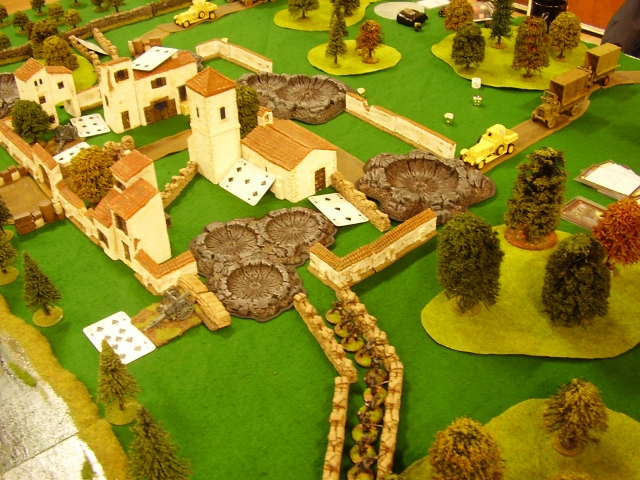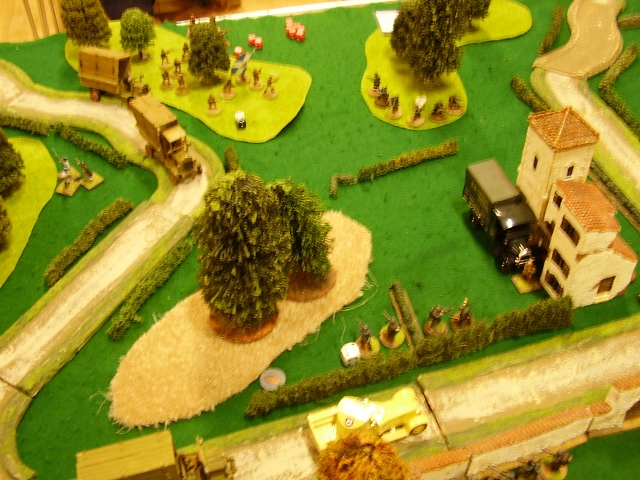The Hungarian Army crosses into Trans-Syldavian lands - nearest are units of Grenz Light Infantry, Jagers and the Don Miguel Line Regiment plus guns, in the middle are a lot of dashing Hussars, and far way are Grenz Infantry and Jagers, with more cannon.
For various reasons (
see here) we decided to play
1848-49 War of the Hungarian Independence battles, with 28mm figures (to capture the gloriously gaudy uniforms).
In the early period of the War, the fighting was mainly skirmish level fighting, which we have been doing as we build up our forces. The Serbians mainly had
non trained local Serbs,
and from the Turkish territories. These are all all
irregular but tough Balkan
bandits - Bashi Bazouks. Also available were some Serbs fighting in
Austrian service - the Grenz regiments, plus Czaikisten from the river
fleet who served on foot as an artillery
unit,
equipped with 6pdr guns.
As I didn't have any Serb figures, but had quite a lot of Turkish and
generic Balkan troops plus various Zouave types lying around, I invented a small Balkan
Imagi-Nation - Trans-Syldavia - to model the sorts of Balkan forces revolting
against the Hungarian boot. Their uniforms (oddly enough) looked exactly like
my figures.....(the Hungarians can't tell the difference between all these Balkan peoples anyway..)
On the Hungarian side, the government called on the 14th.
and 15th. (Szekeler) Grenz Regiments, because these regiments were mainly formed of Hungarians, and they also had the Hungarian line
infantry regiments, artillery, plus Honved infantry - freshly raised volunteer
infantry - and of course, their famous Hussars. And so, they launched attacks all along the Balkan borders.
Initially Trans Syldavia saw little more than skirmishing raids, but on Monday 17 September, after months of low level skirmishing, the Hungarian forces finally made a major push into TransSyldavia and crossed the Trans-Syldavian border at the head of the Stazni valley, clearly wanting to own this main road before the snows came. Companies of the Don Miguel Infantry Regiment, the 14th Grenz Infantry, Hungarian Jagers and Insurrection Hussars, supported with 6 pounders, made a move to capture the village of Malo Cena, and secure the road down the valley and onto the Trans-Syldavian plains.
Throughout the months of skirmishing, a large band of
irregulars defended Malo Cena and the Stazni Valley, based around the village at the
head of it. They had been supported with a company of ex-Austrian
Grenz infantry and their 3pdr battalion guns. This small force had recently been reinforced by a band of Trans Syldavian irregulars, fleeing from Hungary.
This force was ordered to make a stand at the village, to give time for reinforcements to get up the valley. They decided to meet the Hungarians on the rolling neadows where the farmland and orchards start, so they could use its cover and retire to the village as a second line. So, on that morning, these forces took cover in the orchards and crop fields and awaited the onslaught, led by the firebrand Bishop Splenetic (below)
Trans Syldavians await the Hungarian onslaught - front (right flank) are some irregular Trans Syldavian nationals from Hungarian lands, flying the Austrian flag, in the cabbage fields. Behind them by the wheat fields are the Bishop, Grenz infantry and 3pdr, behind themt a troop of Huszars who had arrived. And far in the distance on the left flank are Trans Syldavian irregular bashi-bazoukhs in the orchard.
Soon the Hungarians advanced into view, coming over the rolling meadows, in 3 divisions - on the left and right flanks they had mixed Line Infantry, Grenzers and Jagers, with gusns. In the centre a large force of Hussars
The Hungarian right division - Line infantry, Grenzers, Jagers and 6 pdr guns painted in Hungarian stripes. Behind them can be seen the Hussars
The Hungarian infantry seemed to advance very very cautiously, but not so the Hungarian Hussars who galloped with great dash across the meadows, and attacked the guns and sabred the gunners who hadn't run. They swirled around the Grenzers (who had retired into the wheat fields) and one detachment charged the Trans Syldavian Huszars who had been trying to manouevre around the flank.
Hungarian Hussars thunder down the meadows
The Trans Syldavian Huszars however, although caught to flank (the dreaded 3 move charge), turned, received the Hungarian charge at the halt, shot their carbines, then pulled out the multitude of pistols secreted in their cummerbunds, fiired those, then proceded to whack the Hungarians with their sabres, axes, maces and whatever other ironwork they carried. The Hungarians fled the field, never to return! (splendid dicing - Huzzah!)
By now the Hungarian left flank Jagers and guns had advanced and were skirmishing with the irregulars in the cabbage fields, but their right flank had decided to halt.
This delay prevented the Hungarians from launching a concerted assault on the small holding force, so valuable time was bought. Then the drums of the relief force were heard on the far left flank. The Duke's son led 2 companies of the freshly recruited Trans Syldavian 1st infantry regiment, plus some of the local milita and gendarmes, and their 3 pdr guns. This force marched at full speed at the still reluctant Hungarian right, the bashi bazouhks in the orchard and the Huszars moving up with them to cover the flank.
Relief on the Left Flank - 2 units of freshly raised TransSyldavian infantry (blue coats, far left) and city militia (white coats, centre) move up quickly in attack column to assault the Hungarian right and turn a flank. The bashi bazoukhs (right) occupy a knoll on the flank, but (right, top) the remaining Hungarian cavalry is moving to support
With the bravado of inexperience the TransSyldavians charged the Hungarian line, the Grenzers fled at the point of the bayonet but the Don Miguel infantry stood and slugged it out The threat from the Hungarian cavalry disappeared after the artillery found their range and the bashi-bazoukhs started peppering them from the knoll and they retired.
Could the inexperienced TransSyldavians pull off an historic victory?
Action on the reluctant Hungarian Right Flank. Trans Syldavian Infantry and units of the Hungarian Don Miguel regiment and Jagers in furious melee
The Hungarian Jagers then countercharged, the 6 pdrs opened up on the Huszars, and the old salts of the Don Miguel shoved the inexperienced infantry back. Being attacked by fresh troops was too much and one of the Trans Syldavian comapnies broke, the other retired, and the Huszars felt they had done enough and also retired at full gallop.
On the other flank, a concerted charge through the cabbages by 2 units of Hungarian Grenzers forced the irregulars in there to retire, and the Bishop and his Grenzers retirds though the wheatfield in good order.
The Hungarians had won the field - but quite a few of their units were shaken or scattered, and theiir hussars were in no state to pursue, so the Trans Syldabvian forces retired to the village in the gathering darkness.
Round One to the Hungarians on points, but no knockout blow and they had had a few shocks from poorer troops.
Footnote - in this period,
the Austrian army officially supported the Hungarian Government. Unofficially though they supported the Serbs for the Rebellion, so the situtation was very confusing.
As the King was weak, Vienna accepted the
Hungarian rebellion, but at the same time they secretly supported the other
minor nations inside the Empire to rebel against the Hungarians. Then, when the
Habsburg throne felt strong enough, they started fighting against the Hungarians openly. So, there is a time limit here - can the Hungarians overrun Trans-Syldavia quickly enough, before unofficial Austrian arms supplies and advisors can beef up its forces, or even Austrian reinforcements
are painted appear?
We shall see....
(Update - the second battle in the mini campaign is now
over here)
On using Black Powder on such a small game - the rules flow well, great fun with the reluctant Hungarian right flank commander (no doubt shot by now for cowardice) but we felt on a 6x4 table we shuld halve movement (and maybe range) as the "3 move cavalry assault" is too fast. Also, h2h combat is very quick in its impact vs shooting, we can see how over multiple combats in a big game with huge forces it evens out, but may look at making it last a bit longer for these smaller games.















































